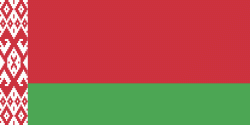Babruysk
 |
 |
Babrujsk occupies an area of 66 km2, and comprises over 450 streets whose combined length stretches for over 430 km.
Babrujsk is located at the intersection of railroads to Asipovichy, Zhlobin, Aktsyabrski and roads to Minsk, Homyel, Mahilyow, Kalinkavichy, Slutsk, and Rahachow. It has the biggest timber mill in Belarus, and is also known for its chemical, machine building and metal-working industries.
In 2021, there were 38 public schools in Babrujsk, with over 24,000 students. There are three schools specializing in music, dance and visual arts. Additionally, there is a medical school and numerous professional technical schools.
Babruysk is one of the oldest cities in Belarus. It was first mentioned in writing in the middle of the 14th century. Investigations by archaeologists revealed that in the 5th and 6th centuries there existed Slavic settlements up the river Biarezina from where Babruysk is currently located; findings of stone tools and weapons suggest that people have lived in the area since the Stone Age.
During the reign of Vladimir I, Prince of Kiev, in place of modern-day Babruysk there was a village whose inhabitants were occupied with fishing and beaver trapping. This is where the name Babruysk originated. For many centuries Babruysk was part of the Polish–Lithuanian Commonwealth and was an important militarily fortified border post. In the 14th century a castle was built on one of the hills near the Berezina River.
Babruysk was not only a major military base, but also a prominent trade center. There is evidence of a market containing nearly one hundred stalls, which implies significant financial activity. In the first half of the 17th century Babruysk became a big trade outpost thanks to its strategic position at the intersection of major trade routes and the Berezina river. There was a flowering of skilled tradesmen, including carpenters, blacksmiths, goldsmiths, and bakers. The population in the first half of the 17th century was between 2,000 and 5,000 people.
The town was surrounded by fortifications made from wood and earth, whose length stretched for over 3 km. These included a protective earth barrier, wooden walls, and almost a dozen two-story watchtowers. In the walls there were openings designed for the placement of firearms. After the Second Partition of Poland in 1793 it came into the hands of Imperial Russia. In 1810, the construction of a fortress began to mark the border between Russia and Austria and Prussia; in 1812 it was almost completed and was successful in repelling Napoleon's attack for four months. After the war the building was renewed on a large scale, and it was completed in 1820. That was one of the western Russian fortresses. The Babruysk fortress has served its purpose for many decades and today it is a major tourist attraction.
The 1861 census showed a population of 15,766. The ethnic groups living in Babruysk included Belarusians, Ukrainians, Poles, and Jews. As in other cities of Belarus, most of the buildings were constructed from wood. In 1866 there were 1498 houses, only 29 of which were made from brick.
There was a steady increase in the Jewish population of Babruysk following the Napoleonic wars. By 1897, in the population of 34,336 citizens, 60%, or 20,760 were Jews. Most of them were employed in crafts, industry, and trade.
Map - Babruysk
Map
Country - Belarus
 |
 |
| Flag of Belarus | |
Until the 20th century, different states at various times controlled the lands of modern-day Belarus, including Kievan Rus', the Principality of Polotsk, the Grand Duchy of Lithuania, the Polish–Lithuanian Commonwealth, and the Russian Empire. In the aftermath of the Russian Revolution in 1917, different states arose competing for legitimacy amid the Civil War, ultimately ending in the rise of the Byelorussian SSR, which became a founding constituent republic of the Soviet Union in 1922. After the Polish-Soviet War, Belarus lost almost half of its territory to Poland. Much of the borders of Belarus took their modern shape in 1939, when some lands of the Second Polish Republic were reintegrated into it after the Soviet invasion of Poland, and were finalized after World War II. During World War II, military operations devastated Belarus, which lost about a quarter of its population and half of its economic resources. The republic was redeveloped in the post-war years. In 1945, the Byelorussian SSR became a founding member of the United Nations, along with the Soviet Union.
Currency / Language
| ISO | Currency | Symbol | Significant figures |
|---|---|---|---|
| BYN | Belarusian ruble | Br | 2 |
| ISO | Language |
|---|---|
| BE | Belarusian language |
| RU | Russian language |















